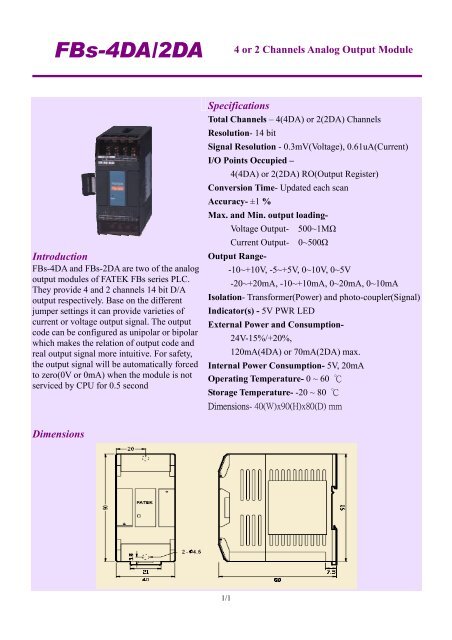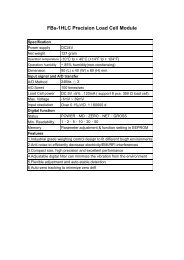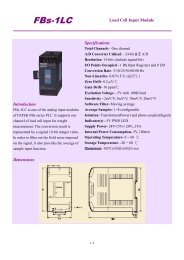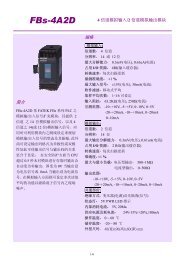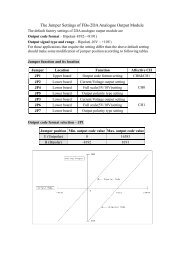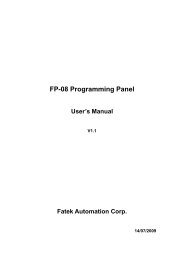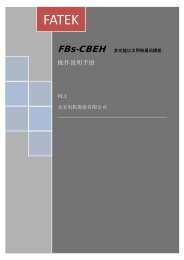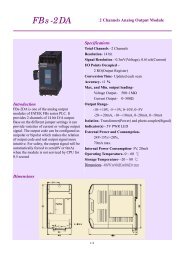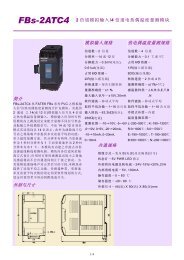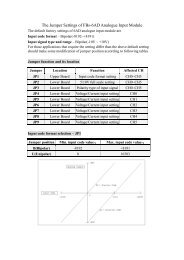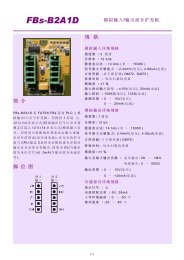FBs-4DA/2DA 4 or 2 Channels Analog Output ... - SEA spol. s ro
FBs-4DA/2DA 4 or 2 Channels Analog Output ... - SEA spol. s ro
FBs-4DA/2DA 4 or 2 Channels Analog Output ... - SEA spol. s ro
You also want an ePaper? Increase the reach of your titles
YUMPU automatically turns print PDFs into web optimized ePapers that Google loves.
<st<strong>ro</strong>ng>FBs</st<strong>ro</strong>ng>-<st<strong>ro</strong>ng>4DA</st<strong>ro</strong>ng>/<st<strong>ro</strong>ng>2DA</st<strong>ro</strong>ng><br />
4 <st<strong>ro</strong>ng>or</st<strong>ro</strong>ng> 2 <st<strong>ro</strong>ng>Channels</st<strong>ro</strong>ng> <st<strong>ro</strong>ng>Analog</st<strong>ro</strong>ng> <st<strong>ro</strong>ng>Output</st<strong>ro</strong>ng> Module<br />
Int<strong>ro</strong>duction<br />
<st<strong>ro</strong>ng>FBs</st<strong>ro</strong>ng>-<st<strong>ro</strong>ng>4DA</st<strong>ro</strong>ng> and <st<strong>ro</strong>ng>FBs</st<strong>ro</strong>ng>-<st<strong>ro</strong>ng>2DA</st<strong>ro</strong>ng> are two of the analog<br />
output modules of FATEK <st<strong>ro</strong>ng>FBs</st<strong>ro</strong>ng> series PLC.<br />
They p<strong>ro</strong>vide 4 and 2 channels 14 bit D/A<br />
output respectively. Base on the different<br />
jumper settings it can p<strong>ro</strong>vide varieties of<br />
current <st<strong>ro</strong>ng>or</st<strong>ro</strong>ng> voltage output signal. The output<br />
code can be configured as unipolar <st<strong>ro</strong>ng>or</st<strong>ro</strong>ng> bipolar<br />
which makes the relation of output code and<br />
real output signal m<st<strong>ro</strong>ng>or</st<strong>ro</strong>ng>e intuitive. F<st<strong>ro</strong>ng>or</st<strong>ro</strong>ng> safety,<br />
the output signal will be automatically f<st<strong>ro</strong>ng>or</st<strong>ro</strong>ng>ced<br />
to ze<strong>ro</strong>(0V <st<strong>ro</strong>ng>or</st<strong>ro</strong>ng> 0mA) when the module is not<br />
serviced by CPU f<st<strong>ro</strong>ng>or</st<strong>ro</strong>ng> 0.5 second<br />
Specifications<br />
Total <st<strong>ro</strong>ng>Channels</st<strong>ro</strong>ng> – 4(<st<strong>ro</strong>ng>4DA</st<strong>ro</strong>ng>) <st<strong>ro</strong>ng>or</st<strong>ro</strong>ng> 2(<st<strong>ro</strong>ng>2DA</st<strong>ro</strong>ng>) <st<strong>ro</strong>ng>Channels</st<strong>ro</strong>ng><br />
Resolution- 14 bit<br />
Signal Resolution - 0.3mV(Voltage), 0.61uA(Current)<br />
I/O Points Occupied –<br />
4(<st<strong>ro</strong>ng>4DA</st<strong>ro</strong>ng>) <st<strong>ro</strong>ng>or</st<strong>ro</strong>ng> 2(<st<strong>ro</strong>ng>2DA</st<strong>ro</strong>ng>) RO(<st<strong>ro</strong>ng>Output</st<strong>ro</strong>ng> Register)<br />
Conversion Time- Updated each scan<br />
Accuracy- ±1 %<br />
Max. and Min. output loading-<br />
Voltage <st<strong>ro</strong>ng>Output</st<strong>ro</strong>ng>- 500~1MΩ<br />
Current <st<strong>ro</strong>ng>Output</st<strong>ro</strong>ng>- 0~500Ω<br />
<st<strong>ro</strong>ng>Output</st<strong>ro</strong>ng> Range-<br />
-10~+10V, -5~+5V, 0~10V, 0~5V<br />
-20~+20mA, -10~+10mA, 0~20mA, 0~10mA<br />
Isolation- Transf<st<strong>ro</strong>ng>or</st<strong>ro</strong>ng>mer(Power) and photo-coupler(Signal)<br />
Indicat<st<strong>ro</strong>ng>or</st<strong>ro</strong>ng>(s) - 5V PWR LED<br />
External Power and Consumption-<br />
24V-15%/+20%,<br />
120mA(<st<strong>ro</strong>ng>4DA</st<strong>ro</strong>ng>) <st<strong>ro</strong>ng>or</st<strong>ro</strong>ng> 70mA(<st<strong>ro</strong>ng>2DA</st<strong>ro</strong>ng>) max.<br />
Internal Power Consumption- 5V, 20mA<br />
Operating Temperature- 0 ~ 60 ℃<br />
St<st<strong>ro</strong>ng>or</st<strong>ro</strong>ng>age Temperature- -20 ~ 80 ℃<br />
Dimensions- 40(W)x90(H)x80(D) mm<br />
Dimensions<br />
1/1
<st<strong>ro</strong>ng>FBs</st<strong>ro</strong>ng>-<st<strong>ro</strong>ng>4DA</st<strong>ro</strong>ng>/<st<strong>ro</strong>ng>2DA</st<strong>ro</strong>ng><br />
4 <st<strong>ro</strong>ng>or</st<strong>ro</strong>ng> 2 <st<strong>ro</strong>ng>Channels</st<strong>ro</strong>ng> <st<strong>ro</strong>ng>Analog</st<strong>ro</strong>ng> <st<strong>ro</strong>ng>Output</st<strong>ro</strong>ng> Module<br />
Wiring Diagram<br />
2/2
<st<strong>ro</strong>ng>FBs</st<strong>ro</strong>ng>-<st<strong>ro</strong>ng>4DA</st<strong>ro</strong>ng>/<st<strong>ro</strong>ng>2DA</st<strong>ro</strong>ng><br />
4 <st<strong>ro</strong>ng>or</st<strong>ro</strong>ng> 2 <st<strong>ro</strong>ng>Channels</st<strong>ro</strong>ng> <st<strong>ro</strong>ng>Analog</st<strong>ro</strong>ng> <st<strong>ro</strong>ng>Output</st<strong>ro</strong>ng> Module<br />
Jumper Setup<br />
<st<strong>ro</strong>ng>Output</st<strong>ro</strong>ng> Code F<st<strong>ro</strong>ng>or</st<strong>ro</strong>ng>mat Selection<br />
There are two f<st<strong>ro</strong>ng>or</st<strong>ro</strong>ng>mats of output code can be selected, one is Unipolar and the other is Bipolar. The range<br />
of the Unipolar code value is 0~16383 while the Bipolar is –8192~8191. The extreme two ends of the<br />
code value c<st<strong>ro</strong>ng>or</st<strong>ro</strong>ng>responding to the minimal and maximal analog output level respectively. F<st<strong>ro</strong>ng>or</st<strong>ro</strong>ng> example, if<br />
the analog signal is set to –10V~+10V range, f<st<strong>ro</strong>ng>or</st<strong>ro</strong>ng> the same code value 0, the Bipolar code will result 0V<br />
output, while the Unipolar code will result –10V output, f<st<strong>ro</strong>ng>or</st<strong>ro</strong>ng> the code value 8191, the Bipolar code will<br />
result 10V output, while the Unipolar code will result 0V output.<br />
Code F<st<strong>ro</strong>ng>or</st<strong>ro</strong>ng>mat Range JP1 Setting<br />
Bipolar -8192 ~ +8191<br />
Unipolar 0 ~ 16383<br />
<st<strong>ro</strong>ng>Output</st<strong>ro</strong>ng> Signal Type Selection<br />
The output signal type of each channel can be set individually. There are two jumpers f<st<strong>ro</strong>ng>or</st<strong>ro</strong>ng> each channel to<br />
cont<strong>ro</strong>l the output signal type. The c<st<strong>ro</strong>ng>or</st<strong>ro</strong>ng>responding jumpers f<st<strong>ro</strong>ng>or</st<strong>ro</strong>ng> each channel are shown at below:<br />
CH0<br />
CH1<br />
CH0<br />
CH1<br />
JPA<br />
JPB<br />
CH2<br />
CH3<br />
CH2<br />
CH3<br />
JP1<br />
3/3
<st<strong>ro</strong>ng>FBs</st<strong>ro</strong>ng>-<st<strong>ro</strong>ng>4DA</st<strong>ro</strong>ng>/<st<strong>ro</strong>ng>2DA</st<strong>ro</strong>ng><br />
4 <st<strong>ro</strong>ng>or</st<strong>ro</strong>ng> 2 <st<strong>ro</strong>ng>Channels</st<strong>ro</strong>ng> <st<strong>ro</strong>ng>Analog</st<strong>ro</strong>ng> <st<strong>ro</strong>ng>Output</st<strong>ro</strong>ng> Module<br />
The jumper setting f<st<strong>ro</strong>ng>or</st<strong>ro</strong>ng> each type of signal output are shown at below:<br />
Signal Type<br />
JPA Setting<br />
JPB Setting<br />
0~20mA<br />
-20mA~+20mA<br />
0~10mA<br />
-10mA~+10mA<br />
0~10V<br />
-10V~+10V<br />
0~5V<br />
-5V~+5V<br />
The default fact<st<strong>ro</strong>ng>or</st<strong>ro</strong>ng>y settings of <st<strong>ro</strong>ng>FBs</st<strong>ro</strong>ng>-<st<strong>ro</strong>ng>4DA</st<strong>ro</strong>ng>/<st<strong>ro</strong>ng>2DA</st<strong>ro</strong>ng> analogue output module are<br />
<st<strong>ro</strong>ng>Output</st<strong>ro</strong>ng> code f<st<strong>ro</strong>ng>or</st<strong>ro</strong>ng>mat – Bipolar(-8192~+8191)<br />
<st<strong>ro</strong>ng>Output</st<strong>ro</strong>ng> signal type and range – Bipolar(-10V ~ +10V)<br />
F<st<strong>ro</strong>ng>or</st<strong>ro</strong>ng> those applications that require the setting differ than the above default setting should make some<br />
modification acc<st<strong>ro</strong>ng>or</st<strong>ro</strong>ng>ding to the tables listed above<br />
4/4


